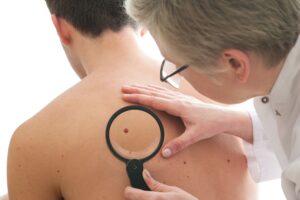
You’ve noticed that a mole on your arm has changed quite a bit over the past year since your last skin cancer screening, and you’re beginning to get nervous. How can you tell if it’s skin cancer? And how will a dermatologist go about making a diagnosis?
The ABCDEs of Skin Cancer
What makes a mole or skin discoloration troubling? What are the red flags a dermatologist is looking for? When your dermatologist conducts a skin cancer screening, he or she is going through what’s called the “ABCDEs” of skin cancer in their head. They are looking for:
A: Asymmetry – Draw an invisible line through the middle of your mole. Are both sides equal? If they’re not, that means they are asymmetrical.
B: Border – Look at the border of the mole. Is it smooth and even? Or is it uneven with scalloped or notched edges? An uneven border is a sign of skin cancer.
C: Color – Most benign moles are one primary color (like brown), but malignant moles will sometimes be a few different colors.
D: Diameter – Measure your mole against the eraser on the tip of a pencil. Is it smaller or larger than the eraser? Melanomas will typically be larger than a pencil eraser, though they could be smaller if caught in the early stages.
E: Evolving – Common moles don’t really change over time. A malignant mole, though, will evolve and change in size, color, and overall appearance. If you notice a mole changing, that’s a warning sign.
Diagnosing Skin Cancer
If your dermatologist finds one or more concerning moles during your skin cancer screening, there’s only one way they can know for sure if there’s a malignancy present: doing a biopsy. Some types of moles can look exactly like melanoma, but be completely benign, so skin cancer isn’t something that can be diagnosed just from a visual inspection.
Biopsies are very common and can be conducted in a matter of minutes with little to no pain. Your dermatologist will numb the area, shave a small layer off to send to pathology for testing, and put a bandage over the site. You’ll just need to keep it clean and apply antibiotic ointment daily to ensure it heals properly. It usually takes about two weeks to receive results, at which time, your dermatologist will contact you to let you know if any further steps will be necessary.
If you do have skin cancer, your dermatologist may need to perform additional tests to narrow down the type of skin cancer and the stage. Eight out of ten patients have basal cell cancer, which grows slowly and doesn’t spread further than the epidermis. If melanoma is discovered, additional testing will reveal if the cancer has spread any further than the mole.
Schedule Your Annual Skin Cancer Screening
Early detection is key in the successful treatment of skin cancer, so making the time to see your dermatologist once a year for a skin cancer screening can save your life.
Ready to schedule your skin cancer screening? Contact Dr. Perri at Perri Dermatology to schedule an appointment at one of our two offices.




